thirty-two

2
TOUCH MAGAZINE | SUMMER 23
ISSUE



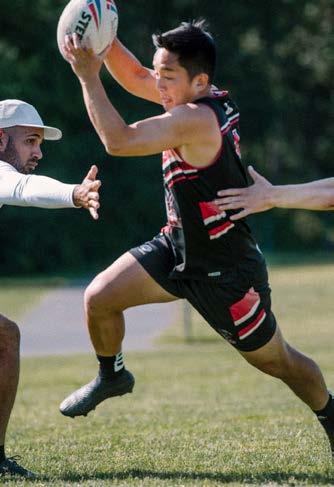
table of contents 6 10 LOCAL TOUCH 06 Mile High Touch Open 10 Canada Nationals 12 Cascadia Cup 14 Summer Showdown LA 16 Rumble in the Jungle 12 16
photo Susi Baxter-Seitz
photo Touch Canada
photo Susi Baxter-Seitz
2 thirty-two
photo Susi Baxter-Seitz



20
AROUND THE WORLD 18 Asia Pacific Youth Touch Cup 20 Atlantic Youth Touch Cup 24 Pride in Touch 28 Euros 30 The Last Samurai 34 Touch Tournament Nutrition TWC 38 Touch World Cup 40 Road to World Cup FINAL WHISTLE 42 Advantage 24
photo Shona Currie
30
photo Robert Perry/Pride In Touch
3 thirty-two
photo Kazuko Kakimoto
Once I hit “publish" and sent the first issue of thirty-two out to the world, I had no idea what would happen next. Sure, some people were going to read it, potentially they would like it, but it’s fair to say I had very low expectations.
I’m happy to report that thirty-two has gone around the world, and has had more than 2,000 reads. I can’t quantify whether this is a lot or not, but it is certainly a lot more than the “maybe it’ll reach a couple of hundred touchies" I had in mind.
This has been a very busy year for touch in the US. Preparations for the Touch World Cup have commenced and tournaments have been happening literally from coast-to-coast. There are a couple of competitions still left before Nationals closes out the season in October. Seeing this sport grow in interest and participation has been special. On top of domestic tourneys, the Asia Pacific & Atlantic Youth Touch Cup have taken place. Watching the young ‘uns showcase all of their skills and athleticism, just like the grown-ups, was both amazing and inspiring. The hardships that come with developing a sport in a country where it’s not part of its culture can be daunting; but to see those kids thriving on an international stage means something is being done right, and a new generation of very competitive and extremely skillful touch players is on the rise.
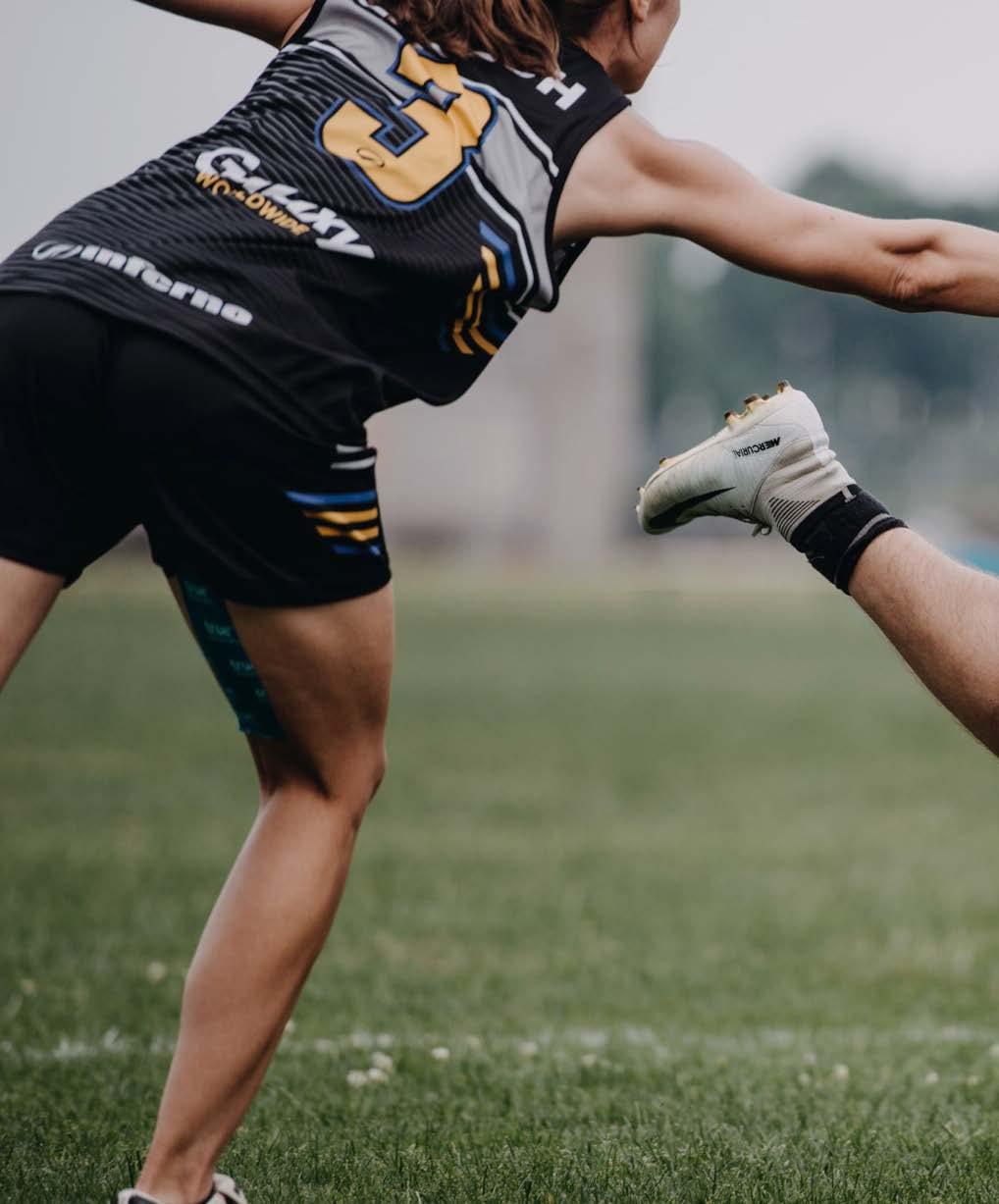
For this issue we also have the pleasure of having Tom Hall from Pride in Touch share a bit of the work they are doing, and what still needs to be done. Nicola Marsh, registered dietician, sports nutritionist and touch player shares some of her knowledge and studies on touch tourney nutrition, Andy Yi takes us on a trip with his experience joining Japan Touch and, to tie it all up with a bow, Matthew Boesen starts a conversation about 'advantage' that is relevant to referees, players and coaches. I’m very proud of how this issue has turned out and incredibly grateful for the people willing to contribute, with words, with images, or by sharing with their community. Special thanks to the wonderful Saphia who has agreed to join me on the editor’s team. I hope you enjoy this issue as much as I enjoyed putting it together!
Susi

MILE HIGH TOUCH OPEN
Text and photos Susi Baxter-Seitz
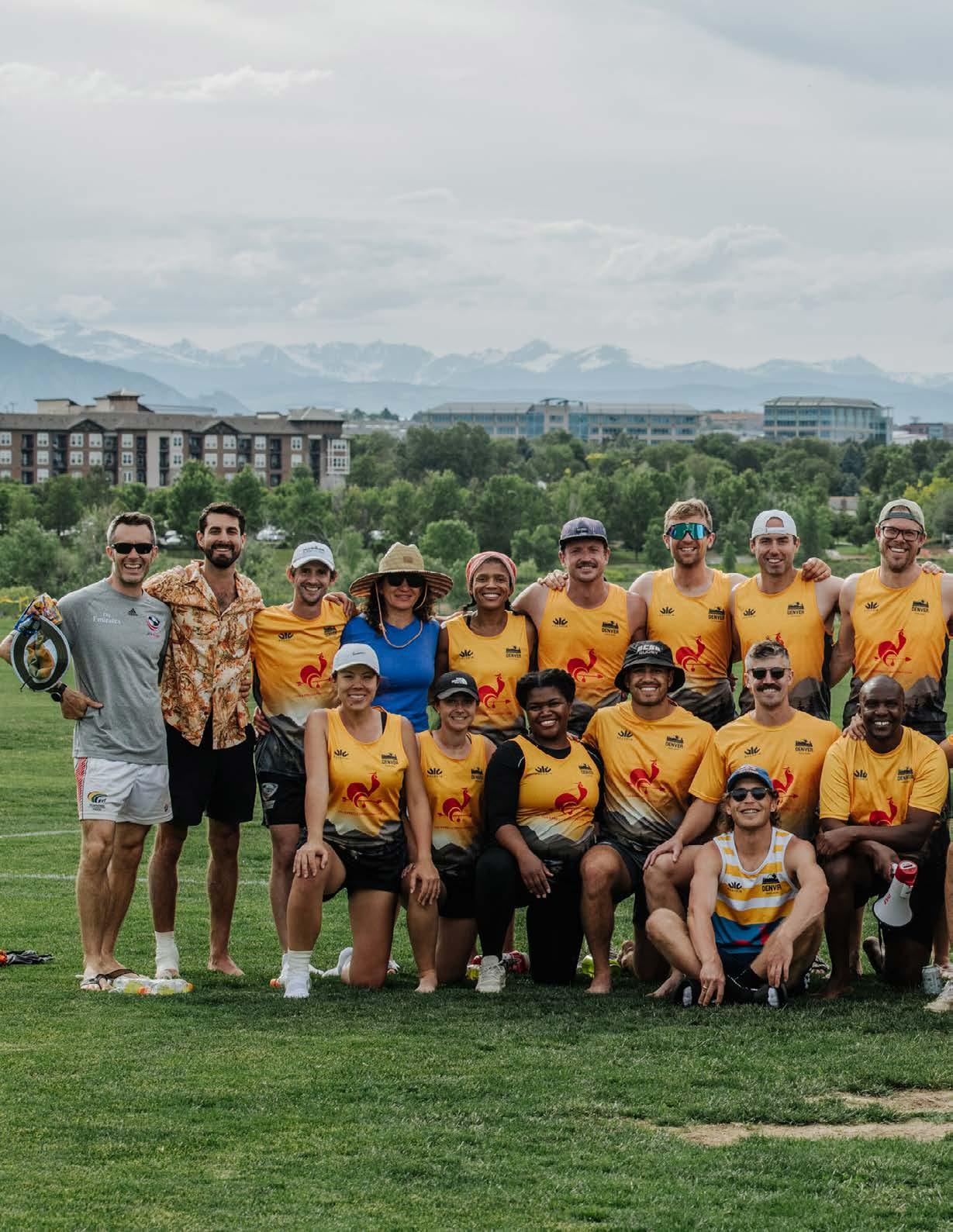
6 thirty-two

7 thirty-two
Denver Touch Rugby (DTR) was established in 2019, the usual touch rugby love-story: former rugby players get together with newto-Colorado touch players for more structured touch sessions, and a club is born. After a successful Nationals campaign, the club had plans to grow – and the next endeavor was hosting a touch rugby tournament – but not any touch tourney; a GREAT one.
Then 2020 happened, and all plans were replaced with the uncertainty of whether there would even be a club when it was safe to play touch again. Some players moved away from Denver, others stopped playing, and it was back to the drawing board. But the touch-gods were smiling down on us, and new additions to the club were as excited about making it grow as those who had left. The Mile High Touch Open was, once again, a feasible goal.
Denver has its peaks and valleys when it comes to hosting a tournament. It is fairly central, easily accessible from either coast, but the window to find an ideal date is small; there is always the possibility Denver will be covered in snow or scorching hot (and it loves a lightning show). The altitude (5,280 ft = 1,608m = 1 mile … Mile High, geddit?) and thin air, plus low humidity, also add to the challenge, but DTR felt confident it was one players were willing to take on.
On June 11th, 2022, the first Mile High Touch Open took place on the grounds of Westminster City Park Recreation Center, a place with luscious grass (despite being completely covered with snow only three weeks before) and an amazing view of the Rockies. Ten teams from across the country fought for the championship title, which was ultimately won by New York after an exciting final against Portland. The standard was set for DTR. The following MHTO would have to be as good, or better than the first one.
And it was. Due to a lack of full-time referees available, the number of teams was limited to eight – but that didn’t mean a decrease in quality of games. In fact, it had the opposite effect. Once again, teams from across the nation descended upon the soft grass carpet in Westminster (with a view) on a very sunny Saturday June 10th. (Luckily not as hot as the previous year!) The games were longer, the referee quality had elevated, and the standard of touch on display was higher than ever. Food truck, families and friends – it was a great day of Touch Carnival.
Last year’s finalists, NYC and Portland, were back to defend their titles, plus teams from Seattle and San Diego. Austin and Denver each sent two teams to round out the competition, and thus we had some of the country’s best players in high contested matches. It was great fun playing, but it was also great fun watching.
Teams were divided into two pools, with the top two of each playing the semifinals; we saw a repeat of last year’s finalists in semi-final 1, NY and Portland, and a repeat of last year’s Nationals finals (Denver Flatirons and Austin1) for the other pool. San Diego beat Denver Red Rocks and claimed 5th place, whilst Austin2 finished 8th and claimed the highly coveted wooden spoon against Seattle. Portland and Austin1 played for 3rd place, with the Hunters coming victorious, whilst NY and Denver Flatirons battled it out in the final and gave the spectators a great show. In the end, it would be New York keeping the title for another year.
The touch calendar for tournaments in 2024 remains to be decided with clubs trying to align with national squad preparations for the Big Dance in July in England. Either way, DTR is proud to raise the standard of US tournaments!
To find out more about our club and keep up to date with the latest news: join our group on Facebook Denver Touch Rugby or follow us on Instagram @denvertouchrugby denvertouchrugby.com
8 thirty-two
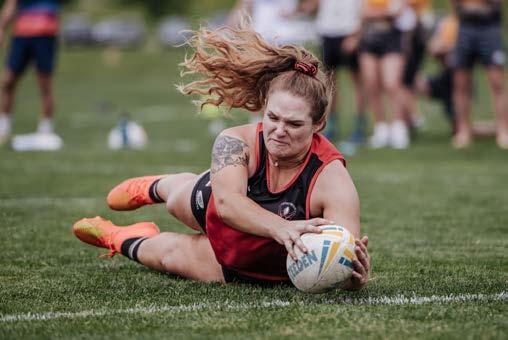


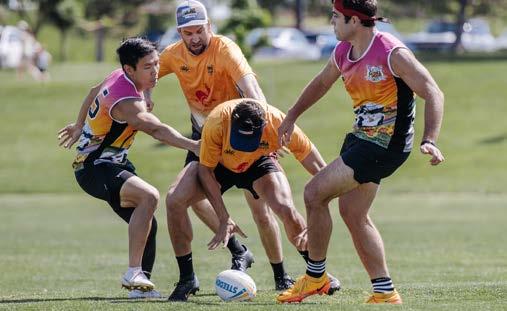
9 thirty-two
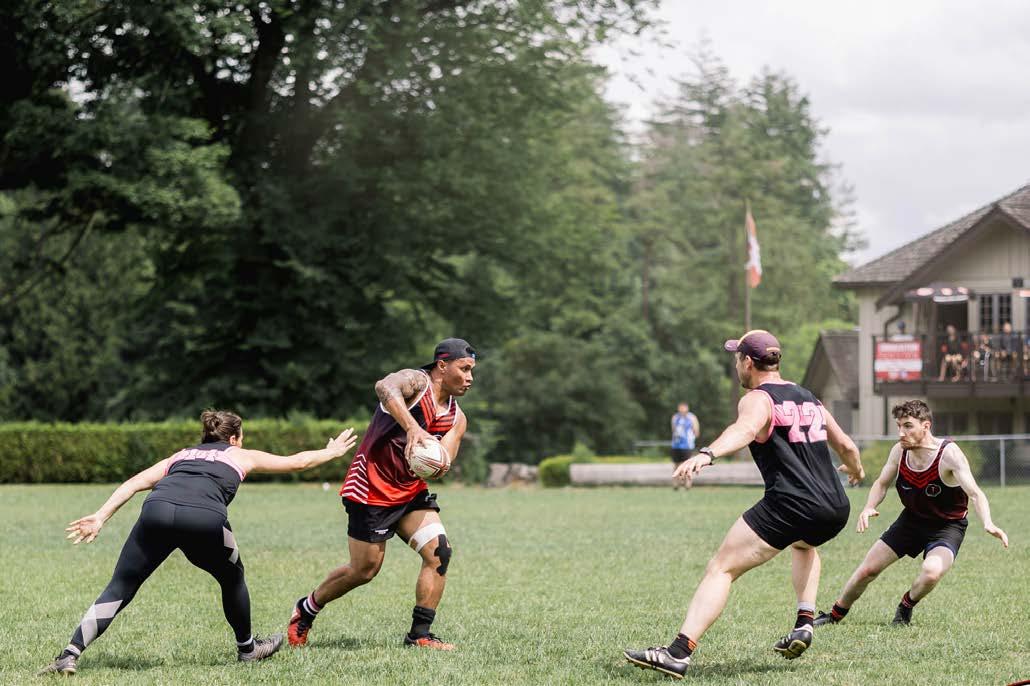


10 thirty-two
CANADA NATIONALS
By Jacob Powers and Saphia Petard Photos Touch Canada
Good news from up north! After a brief hiatus due to the pandemic, Touch Canada is back in action this year, and started strong with an excellent 2023 Canadian Nationals tournament. The event was held on June 17th in Vancouver, BC. Canadian touchies from across the country headed West to compete at Brockton Oval. A lush rugby pitch nestled at the end of Stanley Park, games took place overlooking the Vancouver Harbor and the base of the North Shore mountains.
Although the views could be distracting, the competition remained fierce and focused, with strong representation from Vancouver, Toronto, Ottawa, and Montreal. Seattle also competed with an invitational team, mirroring a long history of Touch Canada/USA Touch collaboration and support. The playing and reffing quality has grown indisputably since Touch Canada's last event, and the whole day was a joy for players and spectators alike.
The tournament also marked the kickoff for Team Canada’s US Nationals campaign – as in previous years, Canada will be selecting a Mixed Open team to compete at USA Nationals this fall in Oklahoma City. Given the stakes, Canadian players were especially keen to showcase their skills, as evidenced by the standard of play set by each of the teams. Ultimately, it was a clean sweep for Vancouver’s two entered teams, who faced off in a hard-fought final that saw Vancouver 1 take the championship.
A big congratulations to all players who participated, and as always thank you to the referees that make tournaments possible. Here’s to many more years of Canadian Nationals – thanks for hosting, Touch Canada!
11 thirty-two
CASCADIA CUP
By Madeline O’Dwyer and Ren Makino Photos Susi Baxter-Seitz and Seattle Touch Rugby
Hosting the Cascadia Cup has become a cherished tradition between Seattle and Portland. The two Pacific Northwest cities take turns as hosts, and what started in 2017 as neighboring touch clubs getting together to scrimmage against each other, has now turned into an impressive, international, all-day tournament.
The 2nd annual Cascadia Cup took place on June 24th in Lacey, Washington. This year, in addition to host team Seattle and two Portland teams, we had a team from Denver and 2 teams from Vancouver, BC (Gangle’s Angels and Meraloma), making this a highly competitive tournament.
Coincidentally, the tournament shared the field complex with the Lacey Polyfest, an event that showcased traditional dances, food, and music of the Polynesian Islands. Players had the opportunity to savor an islandinspired lunch and enjoy post-tournament snacks while immersing themselves in Polynesian culture.
After an intense final match that almost came down to a last-second drop-off, the two Portland teams secured first and second place. Denver claimed 3rd place, defeating Seattle, whom they had previously lost to in the tournament. Seattle, having earned the “wooden spoon” at Denver’s 2022 Mile High Tournament, devised a unique consolation prize called the “Not Last Salmon” award which was given to the penultimate loser. Vancouver’s Gangles Angels were the inaugural recipients of the prize, inspired by Seattle’s own Pike Place Market.
To conclude the day, the players gathered at the local bar, Pints and Quarts, to enjoy some well-deserved, refreshing beverages. What once started as a friendly rivalry between two West Coast cities has transformed into a cross-border, plane-hopping tournament filled with competitive touch matches. The sport of touch has been steadily gaining popularity in the US, and this tournament stands as a testament to its growth. Seattle eagerly anticipates traveling down to Portland as they prepare to host the third official year of the Cascadia Cup. If you’re interested in learning more or joining Seattle Touch, check out:
Email: seattletouchrugby@gmail.com
Instagram: @seattletouchrugby
12 thirty-two

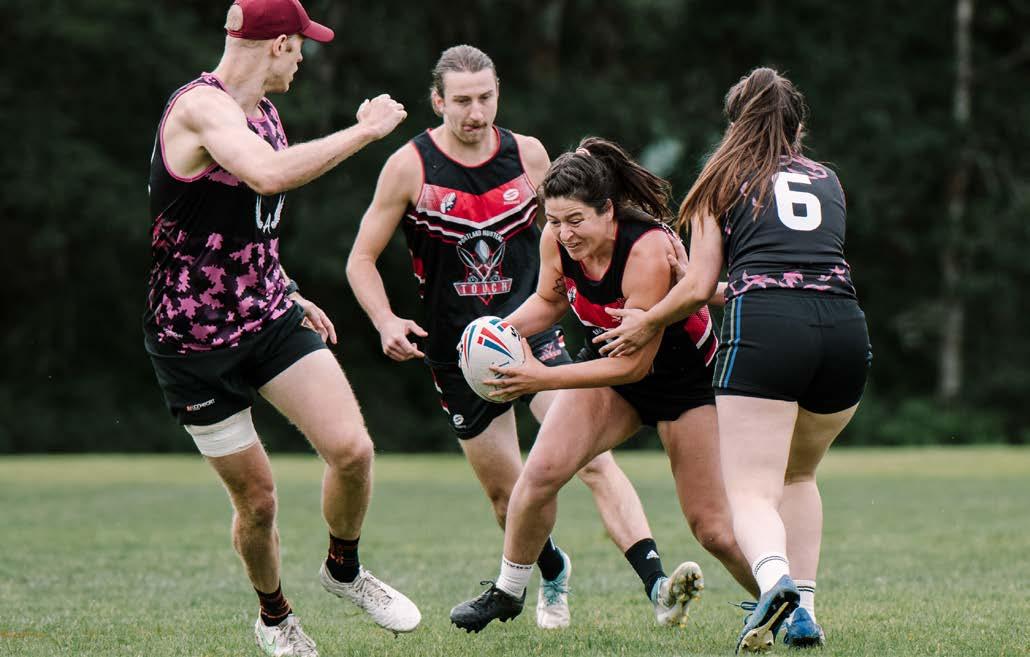
13 thirty-two
SUMMER SHOWDOWN LA
By Nico Whiteford Photos Xavier Lee
On July 15th, in the foothills of Griffith Park, LA and San Francisco came together to host a joint touch rugby tournament. What made this tournament special within our niche community was its distinct men’s and women’s division, as opposed to the more common mixed tournaments we see today. The tournament took about 6 months of hard work to put together. From permits and tents to players and referees, it truly takes a village to put on a functional touch rugby tournament from scratch.
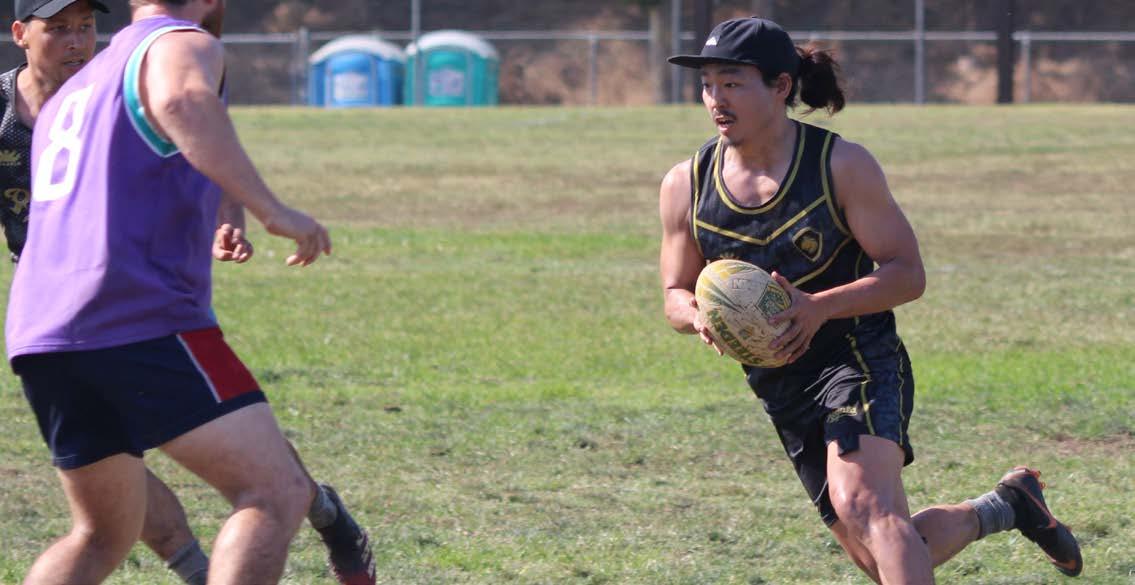
From the get-go, LA accepted logistical advice from the Denver tournament committee; Denver has hosted their late spring tournament for a couple of years. The biggest takeaway and word of advice to future planners is to utilize your local community! You never know who may have access to a local school with an infinite supply of tents (true story). In the future, USA Touch may benefit from a “Tournament Playbook” – not only would this streamline the tournament planning process, but it would also increase collaboration between USA clubs.
Although many experienced players attended the tournament, there were also teams whose players were meeting and working together for the first time ever, but having distinct women’s and all men’s divisions allowed players old and new to reflect on what it may be like to play at Nationals – not only was the tournament logistically up-to-par with Nationals, but the level of touch was up there as well. As the first proper men’s tournament of the year, we had the men’s division really step up to the plate, with the following teams competing: LA Royals, the Hypers (a hybrid team), San Francisco, and San Diego. The women’s division also had 4 teams: San Francisco, Portland, LA Royals, and Pan Pacific (a developing men’s team). Each of the men’s and women’s teams played 5 games total; the day started with a round robin, followed by semi-finals, and then the grand final.
14 thirty-two
The men’s division saw semis between San Diego and the Hypers, and Royals vs San Francisco. The grand final was between the LA Royals and the Hypers, a hybrid bunch that improved greatly throughout the tournament, keeping it a one try difference through most of the grand final. In the end, the underdog Hypers pulled through with a 6 – 3 final score.
It was also clear that the ongoing USA Touch World Cup campaigns have had a huge impact on the energy and social aspect of local tournaments. World Cup camps bring together a mix of players from across the US, and thus there is more familiarity and camaraderie – contributing to more positive sportsmanship across games.

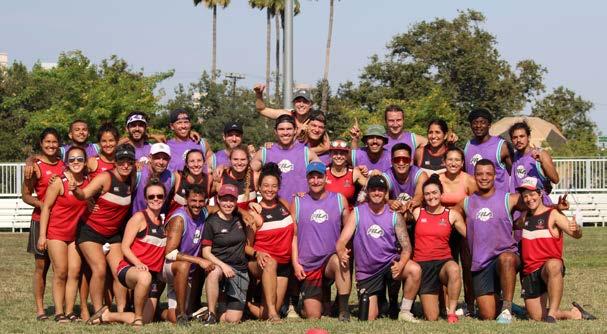
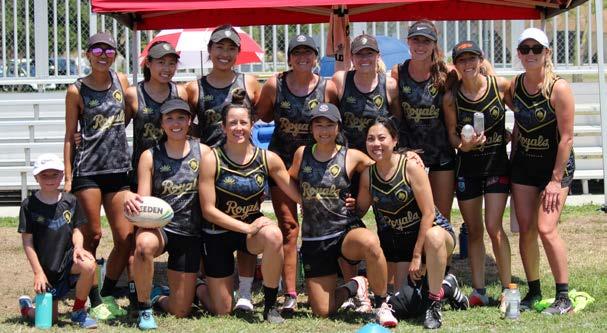
The women had a strong level of touch, as many experienced players have taken part in these types of tournaments before. All teams made the semis with Portland facing off against Pan Pacific, and LA going against SF. In the end, the LA Royals played Portland in the finals, and came out on top with a 8 –6 finish. The LA Royals were able to solidify their already familiar team dynamic by practicing strong touch tactics on the offensive and defensive line, and their fitness level and fluid team dynamic allowed them to take the victory on their home field.

RUMBLE IN THE JUNGLE
By Nico Whiteford Photo Susi Baxter-Seitz
On July 22nd, we were back on Randall’s Island as New York City Touch hosted its annual Rumble in the Jungle tournament. This is the kick-off for the East coast’s summer touch season, in the lead-up to the highly anticipated Nationals tournament this fall.
Seven teams gathered from New York City (WO, MXO, M30), Fort Lauderdale, Toronto, and Boston on two fields right by the East river, split into two divisions, rat and pigeon.
Toronto and Boston, important and seasoned East coast competitors, trekked to the city to make this tournament a reality. Boston have been working hard over the past couple of years to curate a true touch team, by bringing in formulated drives, a defensive stack, and attacking plays. Toronto, don’t let the name deceive you, recruited players from Ottawa, Philly, Singapore, Vancouver, Boston, and of course Toronto to field their Rumble team. Being their third trip down to NYC for Rumble in the Jungle, they have seen some fantastic improvement, largely thanks to their twice a week pickup sessions and once a week skills and drills. The Toronto club has welcomed many new players over the past year, and veteran players are working hard to lead, mentor and grow touch culture up north. We’re lucky to have such a passionate and welcoming group join us at US tournaments! Fort Lauderdale, a fresher team of rugby players, came together with the enthusiasm and drive to learn the seamless structure that touch demands.
The women’s and mixed teams played round robin within their divisions, while the men’s teams played three exhibition games against each other throughout
the day, followed by semis and finals. In the semis, the Boston mixed team took on NYC WO while NYC MXO competed hard against Fort Lauderdale. After a tight game, Boston came out on top, defeating NYC WO in a two-minute, 4v4 drop-off. New York started with the ball, but failed to score, and Boston took home the victory by outpacing the NYC defensive line with a minute to spare. In the other semi-final, the New York MXO team saw a tough game against Fort Lauderdale. From the mixed team’s captain, the MXO went into each game raising the level of touch from the previous round. A few women on the mixed team (Abby, Zeynep, and Tonya) carried with them strong driving tactics and communicative line defense, which made a huge impact to the end result. Fort Lauderdale competed with quick feet and sharp athleticism, forcing the MXO to make in-game adjustments, apply pressure and shut off any run around attempts on the defensive line. By the second half, NYC was on cruise-control, taking the victory and moving into the grand final.
To close out a great day of footy, NYC MXO took on Boston in the grand final. Both teams seemed evenly matched in terms of fitness and speed. At half-time, NYC was leading, but Boston kept up the intensity with some hefty scoops at the score line. In the end, New York came out on top, exploiting Boston's weaknesses on the defensive line, and proving their structured touch could lead them to victory!
Overall, NYC’s Rumble was a successful, humid, and joyful event, chock-full of friendly faces, new and old. The NYC touch community was thrilled to host all the inspired and driven players, and it’s an exciting time for touch in the US as structured play makes its way to budding clubs in major US cities.
16 thirty-two

17 thirty-two
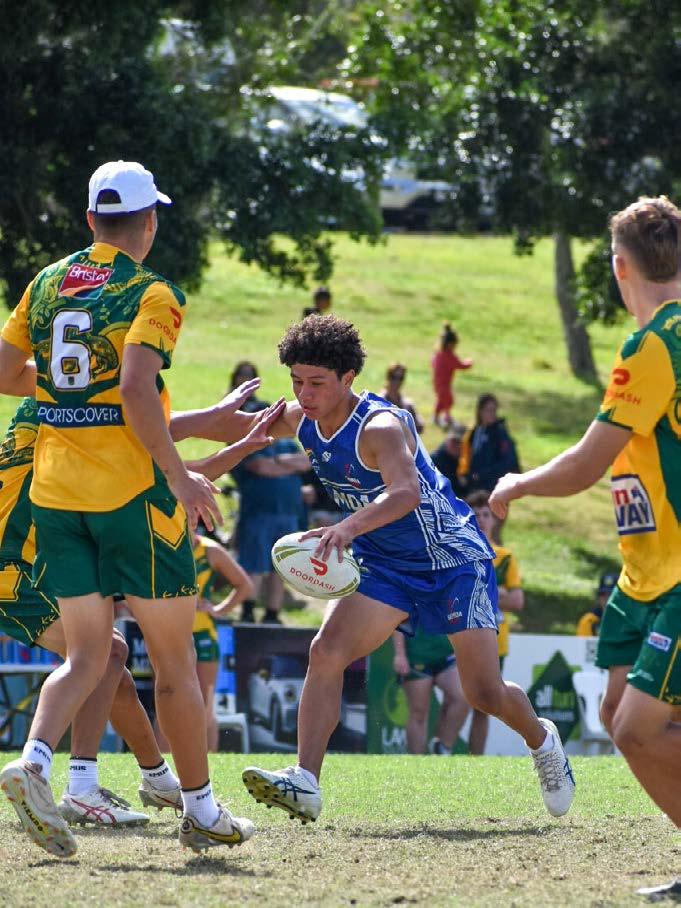
18 thirty-two
ASIA PACIFIC YOUTH TOUCH CUP
“The APYTC is a one-off event to reignite international youth competitions following the cancellation of the 2021 FIT Youth World Cup. Due to the cost and logistical challenges of attending one centralised World Cup so soon after the pandemic, two separate events have been created in both the Southern and Northern hemispheres to provide greater opportunities for nations to restart their youth programs.”
Location: Brisbane, Australia
Date: May 12th–14th 2023
Nations: Australia > Boys' 18, Girls' 18, Mixed 18, Men's 20, Women's 20 and Mixed 20
Cook Islands > Boys' 18 and Girls' 18
Fiji > Boys' 18, Men's 20 and Women's 20
Malaysia > Girls'18 and Men's 20
New Zealand > Boys' 18, Girls' 18, Mixed 18, Men's 20, Women's 20 and Mixed 20
Niue > Men's 20
Papua New Guinea > Men's 20 and Women's 20
Philippines > Mixed 20
Samoa > Mixed 20
Singapore > Girls'18
Grand Finals: Boys' 18 Australia 12 vs 9 New Zealand
Girls' 18 Australia 13 vs 3 New Zealand
Mixed 18 Australia 12 vs 11 New Zealand
Australia 12 vs 7 New Zealand
Australia 8 vs 7 New Zealand
Men's 20 Australia 12 vs 3 New Zealand
Women's 20 Australia 12 vs 2 New Zealand
Mixed 20 Australia 18 vs 4 Philippines
19 thirty-two
Photo LK_Sportsphotography
ATLANTIC YOUTH TOUCH CUP
By Augustine McMahon Photos Shona Currie
Afew days before I made the journey up to Nottingham this past July, I received an email from the parent of one of my USA U15 Mixed players. This email contained a beautifully honest reflection on that parent’s own experiences of youth international competition, which remained for her some of her most cherished and prized memories. I mention this reflection here for one simple reason: because I am grateful for it; as I read these heartfelt memories, suddenly the importance of the Atlantic Youth Touch Cup, and its sister tournament the Asia Pacific Youth Touch Cup, snapped into an altogether clearer light. Anyone who was present in Nottingham this July; anyone arriving to play in their first international tournament or their last at a junior grade; anyone who watched on as, throughout the week, the colours of ten nations began to fill the university campus, could not have failed to be swept up in the excitement and anticipation of the inaugural Atlantic Youth Touch Cup (AYTC). When, on Thursday 20th July, all these nations, colours, teams, and people found themselves concentrated in the players’ village of the Highfield’s Sports Complex, the result was an opening ceremony that overflowed with joy.
One of my abiding memories of the entire week came during this ceremony as, in the communal space between each nations’ tent, I glanced up to see one of our youngest U15s being hoisted up onto their older countrymen’s shoulders to parade their country’s flag – their face radiating complete and utter delight. Moments like this were, I am sure, experienced by all in some way or another and this was, of course, due in no small part to the organisers and volunteers who worked tirelessly throughout the tournament to ensure a smooth and enjoyable experience for all involved. To them I can offer only the sincerest of thanks.
Once the joyous noise of the opening ceremony settled into a contented hum, there was one thing left to do: tap off and play footie. I’m going to ask you now to draw on your own experiences. As a reader of this magazine I’m going to make the bold assumption that you are, in some way, a Touchie. Whether you are an avid player, a keen referee, or even a newly interested fan of the sport, I would wager that, at some point, you have had the task of trying to convince a mate, a colleague, or a family member to come with you down to the park and give Touch a try. I would ask you to try and consider the arguments you used to weasel that extra player along.
“It’s a sport for everybody!” you might have quipped.
“If you can throw and catch, you can play Touch” is another go to line I have heard (and used) many a time.
These are all 10/10 Touch pick-up lines, and our sport is all the better for every friend and family member brought into it. However, I would also argue that each of these lines is perhaps only telling a half-truth. Each of these lines probably has a second part: “it’s a sport for everybody; but at the elite level there is a certain skill-set and level of athleticism required” “if you can throw and catch, you can play touch; but there is also a lot more technical and theoretical knowledge that you need if you want to compete at the higher levels of the game.” The truth is, our game is at a point in its development where there can be quite considerable gulfs in performance levels, and more often than not this is drawn out noticeably on the international stage.
Let me state from the outset that this is in no way a criticism of either side of this fact. I am merely developing thoughts sparked by the observations of Mr
20 thirty-two

21 thirty-two
George Jahnke on “The Touch Project” podcast, who remarked that as Touch becomes more specialised, its accessibility and outreach potential narrows. I fully believe our sport requires high performance pathways and programs. Spaces in which committed individuals can excel and push the boundaries of not only their capabilities, but those of the sport itself, are integral offerings of the sport and part of what makes Touch so special. However, I would also argue it would be to the detriment of these programs to ever neglect or forget that, while their own development is important, the development of the grassroots game and the high performance offerings of countries further down the world rankings are equally so.
Let me explain why the AYTC led me to such a conclusion. To put it simply, were we in for a treat when those games tapped off or what? Across the board young players left everything on the pitch for their teammates and their nations. In the older age groups, hosts England showed just why they have recently been promoted to tier one status. Onehundred percent records in both the Men’s 20, Women’s 20, Boys’ 18, and Girls’ 18 divisions points to the hard-work and dedication of players, coaches, and the England Touch Association alike. In the Mixed 18s division, Wales, who had been strong throughout the tournament, carried their momentum through to an exciting drop-off win in the gold medal match,
overturning their round robin loss to the English side and clinching the title. Meanwhile, in the Mixed 15s a classy French side also managed to topple an equally strong English team when it mattered most. We were even treated to an enthralling test series in the Mixed 20s division between England and South Africa which went right down to the last moment of the final test, narrowly tipping England’s way.
If you did not manage to catch any of the action live, I absolutely encourage you to watch some of the streams up on the International Touch YouTube channel, if only so that you can bear witness to two things: firstly, the array of talent, skill, and knowledge present in the Atlantic right now. From outrageous out the back offloads in final drop-offs, last minute break away scores, beautifully structured and executed attacking platforms, body-line defending, or just unrivaled speed and athleticism, the AYTC had it all. Secondly, so that you can get a taste of the raw passion and emotion that these young players brought to every second of the carnival. To walk around Highfields that weekend was to experience a constant buzz of energy even when, on day three, the heavens opened and the reality of an English summer kicked in. To all the players, coaches, and spectators I cannot thank you enough for the atmosphere of respect, competition, and fun you all brought with you every day.
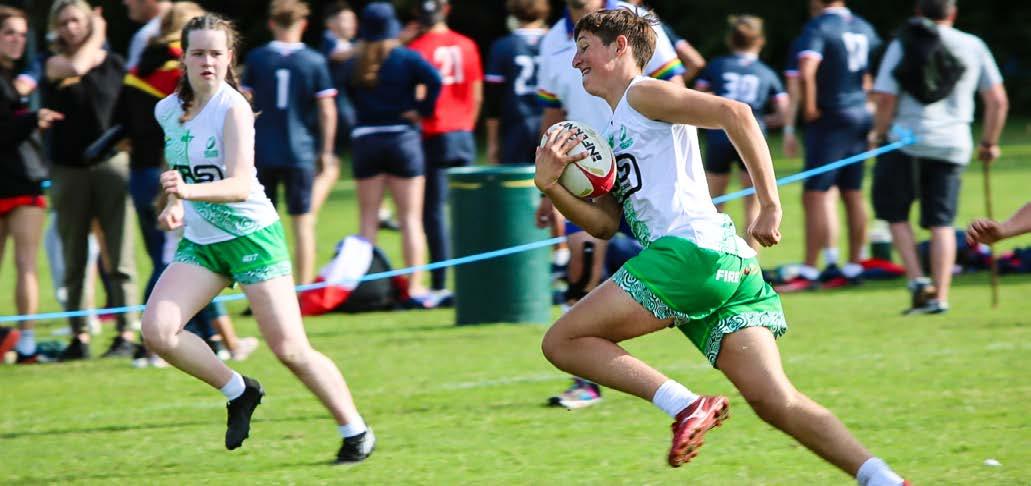
22 thirty-two
While the headlines will of course go to the winners, quietly, nations which, perhaps, have younger Touch associations and programs, are proving that Touch is on the rise around the globe; a win for the United States Womens’ 20s against France, competitive showings from the Cayman Islands and China in the Mixed 15s divisions. Their contribution to this tournament is equally as important as those who took home the medals. At the beginning of this article I said that I thought that youth tournaments like the AYTC were important. I wish now, in light of all of the above, to draw together this line of thought. We have to ask ourselves, what is it about our most cherished memories that makes them so? I would argue that we never really cherish memories of doing something but of feeling something. What made the AYTC so special was that it gave thousands of people, young and old, the opportunity to feel something: triumph, disaster; joy, disappointment. What’s more, they shared this opportunity with others in their teams – be it referee teams, event staff teams, or playing teams – amplifying any such feeling. It is so important that Touch continues to provide these opportunities to its community.

Our sport is inevitably going to grow; it deserves to, and it should. Who wouldn’t want to share the community and opportunities our sport provides with a neighbour or a friend? As we grow, there should and will be high-performance programs that push the frontiers of the game – but the quality of Touch on the pitch alone is not what makes it the sport we all love. It is the community, both local and worldwide, around the sport; it is the connections and feelings we make through the game – which really are unlike those made in any other sport – that give Touch its special place in our hearts just as much as anything that happens on the pitch. The AYTC shouted this message from the rooftops. We have a constant duty, as custodians of the sport, to ensure that no one, both at home and overseas, gets left behind. To do so would be to deprive ourselves of even greater, broader, and more profound competition, connections, and communities on every level of the sport. The Atlantic Youth Touch Cup will always be for me, and I hope for many others, a cherished memory.

23 thirty-two
PRIDE IN TOUCH
Touch can be proud as a home for queer folk
From doodling rainbow vest designs for their social touch club in 2020 to celebrating their third annual tournament, Pride In Touch has been on quite a journey over the past three years. Tom Hall, touch player and co-founder of Pride In Touch, gives us the lowdown on the LGBTQ+ organisation’s journey from its birth in 2020 to its recent tournament in Glasgow. Photos England Touch.
As I travel back from a wet and sunny weekend in Glasgow, nature seems to give me a sign that we’ve created a close connection with this fabulous city. Peering through the window of my taxi and looking beyond the Glaswegian drizzle, I can see a shining rainbow fill the horizon with colour creating an archway above the airport I’m headed for. It makes me reflect briefly on what has felt like an impactful three days in Scotland.
Next to me is my husband and fellow Pride In Touch co-founder, Nick Heath, who is scrolling through the posts and stories we’ve been tagged in following our third annual tournament. After our inaugural event in London and last year’s journey to Manchester, we were so excited to be able to bring our day of pride-filled touch across the border.
It was our biggest tournament so far with 16 social teams taking part from across Scotland and beyond, all coming together to celebrate the LGBTQ+ community. It’s our flagship event and we love the idea that its sense of inclusion and community resonates throughout the touch world.
“The touch community had been waiting for a platform to show the sport’s inclusive values”
This year we were fortunate to collaborate with some amazing people and organisations including Glasgow Lions, Glasgow Centurions, LEAP Sports and Hillhead Sports Club. Like more and more of our initiatives we had a focus on leaving a legacy with the local community, something we discussed at our Seen & Heard seminar on the eve of our tournament.
When we started Pride In Touch in early 2020, as a means to share our colourful rainbow heart tops, we weren’t sure where it would go beyond that. But in just a couple of months we’d had over 1,000 orders for our tops from the UK, Europe and even as far as the USA, Hong Kong and Australia. We quickly realised that the touch community had been waiting for a platform to show that the sport’s inclusive values extend to the LGBTQ+ community.
24 thirty-two

25 thirty-two
From that point we became very good at saying yes to ideas, requests for help, collaborations and anything to help bring more LGBTQ+ folk into the game. After all, the two of us have benefited so much from touch that we felt it was something any queer person should also have access to.
“For some queer people team sport is just an inconceivable idea they left behind at school”
We know that barriers to accessing team sport for the LGBTQ+ community are well documented. The impact is compounded further for those that sit at the intersection of other minority and underrepresented groups. For some queer people team sport is just an inconceivable idea they left behind at school. For others, it’s tainted by lazy language and misguided assumptions.

In some countries, it’s almost impossible to be your true self in your chosen sport due to legal and safety reasons. When I played at the touch World Cup in Malaysia in 2019 for example, LGBTQ+ people could face imprisonment and there were no laws to protect the community. It’s sad knowing that the social, physical and mental benefits of team sport are often harder to access for the LGBTQ+ community.
Fortunately, touch is an inherently inclusive sport. Perhaps due to its popular mixed-gender format and its accessible nature for different age groups. Or maybe it’s the quirky rules and amusing terminology. Whatever it is, touch seems to draw people in, even those who didn’t know they were looking for it.
“97% of respondents say they would be comfortable having a bisexual, lesbian or gay teammate”
At a recent seminar, we shared preliminary results from our first ever survey into touch attitudes and experiences, conducted in collaboration with Dr. Eric Knee from Adelphi University, New York. We weren’t surprised to see that 94% of respondents agreed that touch is an inclusive sport. Interestingly, 84% went as far as to say that touch has a more inclusive culture compared to other sports. There was also agreement that touch is welcoming to sexual minority participants, perhaps reinforced by 97% of respondents saying they would be comfortable having a bisexual, lesbian or gay teammate. Certainly, something for the touch family to be proud of.1
There’s always room for improvement though. While our survey showed that 92% of respondents would be comfortable having a trans or non-binary teammate,
26 thirty-two
nearly half were unfamiliar with existing genderdiverse playing policies. We also saw agreement that touch needs to be more intentional in promoting the inclusion of LGBTQ+ participants.1
For me, this paints a clear picture. Relatively speaking, touch is an inclusive space for the queer community but there needs to be more proactivity and intention to make continued progress. I’ve seen this first-hand as a player. I’m fortunate enough to have enjoyed ten incredible years playing touch but I still hear the term ‘gay’ used in a derogatory way for example. While this has never been directed at me and I know there is no intentional homophobia behind it, the impact of lazy language like this can be significant.
I often hear people say that they would have no problem for an LGBTQ+ person to be a part of their club. On the surface, this may sound positive, but it suggests there is no work to be done and there is no need to look inwardly at how things can be improved. Even at our own Pride In Touch events, we collect feedback on experiences to identify areas we need to work on, which there will always be.
It's heart-warming though, to see where this intentional and proactive effort makes a difference. We recently collaborated with a queer community group called the West London Queer Project and London Eagles touch club to deliver a 12-month programme of touch taster sessions, training and friendly games. We saw hundreds of queer people engage with the programme, which has led to the creation of the West London Warriors, a new LGBTQ+ touch club. We’ve heard several players explain how it gave them a safe and inclusive space to try team sport, find a social community and reap the physical and mental benefits of touch.
We’ve also seen touch governing bodies such as Touch Football Australia and England Touch proactively develop gender-inclusive playing policies for their members. We were lucky enough to receive feedback from one non-binary junior player who said how good it felt to be recognised and supported by their governing body. Although our survey findings suggest more work needs to be done to increase the visibility and understanding of these policies.
Beyond our own annual tournament, we’ve also seen pride events run by other organisations and clubs including the University of Queensland Touch, Midlands Touch Association, Touch Football Australia, Glasgow Touch Association, England Touch, In 2 Touch, Halifax RFC and many more. These types of events are hugely important for visibility and provide a platform for allies to show their support.
Sometimes it can be as simple as taking the time to read a resource, take a training course, wear a rainbow sweatband or use your pronouns. All these things make a difference and quickly add up to create an environment in which queer people will shine. And believe me, queer people do shine in touch and they make our sport even more fabulous!
As my taxi pulls up to Glasgow airport I wonder where we’ll be next year. How many more incredible communities we’ll get to meet, what challenges the queer community will face and how many more lives will be touched by our beautiful sport when they need it most. Finally, I ponder where our tournament will be in 2024. A World Cup year no less. If reading this gives you the motivation to collaborate with us, wherever you are in the world, drop us a DM anytime.
“Queer people do shine in touch and they make our sport even more fabulous!”
27 thirty-two
1: Touch Rugby Environment in the UK: Preliminary Findings from a National Survey. Pride In Touch; Dr Eric Knee, Adelphi University. Presented at Seen & Heard Seminar, University of Strathclyde, July 2023.

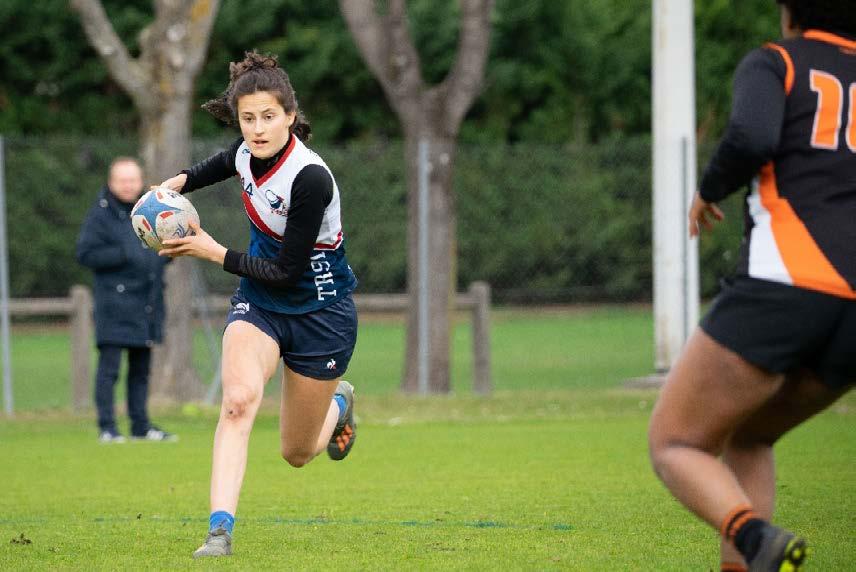

28 thirty-two
EUROS
By Thibault Zettel, Development Director of Touch France
This summer, from August 8th to 12th, France is hosting the European Touch Championships. The event will take place in the very green city of Vichy, in the Auvergne-Rhône-Alpes region. Vichy is part of the major spa towns listed as World Heritage sites by UNESCO, and is an essential destination for sports lovers, both professional and amateur. Over the last few years, Touch France has built a strong partnership with Vichy Sport, through preparations for our national teams and organising events and competitions. Armed with this experience, Vichy successfully hosted the European Junior Championships last year.
Touch is facing challenges in France due to the lack of recognition from sport-governing bodies or traditional rugby associations. Despite these hurdles, through its commitment to and involvement in the community, Touch France is growing and developing numerous projects around training and education.

Organising and participating in international events is key to showing the potential of the sport in France: an inclusive, diverse sport which offers unique access to discover and improve rugby techniques, while embracing communities from all over the world. This summer, Touch France is delighted to welcome 14 nations and 60 teams for the ETC Vichy 2023! Our team is working hard to deliver to the 1000 participants from all over Europe a memorable event and a great practice opportunity before the 2024 Touch World Cup.

29 thirty-two
THE LAST SAMURAI
By Andy Yi Photos Ai Fujita
In the 2003 movie,“The Last Samurai”, Tom Cruise plays a former military officer sent to Japan on a mission; unexpectedly he ends up integrated in a Japanese village learning to adapt to Japanese culture and life, and coming to love and admire the Japanese people and their way of life.
Similar to Tom Cruise’s character (former military officer, 5’7, just as handsome ... kidding, though less Caucasian), the military took me and my family from Orlando, Florida to Japan earlier this year. Knowing we’d be expats in a new country it was a top priority to find a touch rugby community/ family in Japan. I knew this was an opportunity of a lifetime as Japan is the #3 touch rugby nation in the world and the best in Asia; an opportunity not only for myself but my six year old daughter (there are very few youth Touch opportunities that currently exist in the USA and besides Orlando Touch trying to have a couple youth days, nothing for elementary age kids).
Touch makes the world a smaller place, you play at enough tourneys and you start making connections all over the world. First, I reached out to the “King of Step” and Japanese Touch Legend Hide “Hitch” Nara, whom I met 10 years prior at my Touch club in Taipei, Taiwan. He
pointed me to the youth club Kono Rugby Academy (KRA) in Hachioji. I also contacted Kotaro Hayashi, from Komae Touch, a gentleman I’d met the previous summer when he dropped by Orlando Touch practice on a business trip and Daichi “Ankle Breaker” Yago. Both of these gentlemen pointed me to Waseda Touch.
The Way of Compassion
Kono Rugby Academy:
On the second weekend of being in Japan, I took my daughter, Amberle to Kono Rugby Academy. When I showed up my mind was absolutely blown, there were 40+ children from 4 – 12 years old wearing crisp purple uniforms happily participating in touch rugby drills and games. At least half if not more of the participants were girls, which made it less intimidating for my daughter. The coach and founder of the club Coach Akira Kono, noticed our arrival and called the team together in a circle to graciously welcome myself and my daughter to the club.
Though none of the children nor coaches besides Coach Kono could speak English; I could feel their hospitality, warmth, and kindness as they welcomed us in Japanese.
During the practice, one thing that really struck me was how Coach Kono made great efforts to ensure the older, more experienced kids were paired with the younger kids as big brothers and sisters. “Paired” may actually be an understatement as there were 4 older girls holding my daughters hands, encouraging her and teaching her throughout the drills and games. Coach Kono always encouraged and never criticized; and led each drill with a warm smile and often a hearty laugh. Even though none of the children could speak English, they could tell Amberle was at times overwhelmed by the language barrier, both coaches and the older girls went to great lengths using body language and high fives to encourage her. Mr. Kono’s warmth, kindness and welcoming nature was clearly reflected by all the children he led.
Despite the welcoming nature of the club, my daughter still felt insecure with her lack of language skills. Being in a new country and not speaking the language is intimidating for an adult, let alone for a 6 year old. Two of the girls that had assisted my daughter were Coach Kono’s twin girls Ren and Tsuzumi. The second week we showed up to practice I noticed Tsuzumi and some of the older girls making great effort to
30 thirty-two
speak English to Amberle, and patiently used the Google Translate app to communicate with me as well. Even a young 6 year old girl named Kirara greeted my daughter with a hug and ensured Amberle felt part of the team. Afterwards, I talked to Tsuzumi’s mother and found out that 12 year old Tsuzumi had stayed up late the night before; unprompted she was looking up English words and phrases to prepare coaching and assisting my daughter the following day. The act of kindness and servant leadership really moved me and touched my heart (no pun intended). Instead of being annoyed that she had to help a 6 year old newb, this young compassionate child took the time to figure out how to better host and welcome my daughter.
The hospitality and warmth I felt at Kono Rugby Academy toward beginners is unparalleled. I’ve been part of touch clubs and communities in 3 countries now and nothing touches the hospitality toward beginners I felt at Kono Rugby Academy. Every beginner and young child at the club is treated as an honored guest and prioritized by the experience/older members of the club. The older children take ownership in developing the “next generation”/junior members of the club in a way that I’ve rarely seen even adults display. From my understanding this is part of the culture and beautiful spirit of Japan. This is the way, planting the seeds of compassion towards the grassroots and the future of Japan.
The Way of Loyalty Waseda Touch Rugby
You walk into practice at Waseda Touch and the first thing you notice is the diversity in ages and skill level. The first time I showed up to practice the first person that greeted me was 9 year old Nanato, a friendly and gentle boy who is the son of the coach and leader of the team, Coach Masahito (Masa). Young Nanato is a constant at practice and a boy that is destined for greatness; you can see him already channeling his fathers skills and step.
Turn in another direction and you will see a 60+ gentleman named Aki-san, who looks like your typical silver haired, spectacled wise professor still proudly wearing the Waseda Touch colors, and still an integral part of the team. We respectfully call him “Sensei”.
Also, there is always a tall lanky white guy named John Beal, but for some reason Beal translates into“Biru” in Japanese, which means Beer. I was excited to meet Biru-San as he’s one of the only English speakers and only other American that I’m aware of that plays for Japan Touch. I learned he’s lived in Japan for quite a few years so I’m hoping he can help translate. Unfortunately, his Japanese is about as great as mine, GAIJINs; so we go through most practices guessing what Coach Masa is saying and hoping Ogi-San or Junji-San, who both spent some time in the States will be patient enough to translate for us.
Established in 1988, Waseda Touch is the oldest Touch Rugby team in Japan. In its early days Waseda Touch was a dominant team, but over the years many of the players have retired and the current team has a much more social, welcoming and low stress environment than some of the elite teams in Japan.
What I absolutely love and respect about this club is our fearless leader, Coach Masa. The first impression you’ll have of Coach Masa is that he’s a pretty handsome dude, the second thing you’ll notice is that he’s a born leader and an elite player that should probably play for a less social and more elite team. But for some reason practice after practice he patiently sticks with us, teaching drills, pointing out how we can improve, and showing us how the pros do it. He has a quiet, calm, and commanding presence; I’m sure he could play a shogun general in a period movie. This is a guy that scored the highest total tries in the past two nationals, a guy that has both vision for the game and also the skills and step to execute. Along with Daiki-San, who has an insanely precise and beautiful right to left pass (which has resulted in every tourney try I’ve earned in Japan), and Masa’s even more handsome and very athletic younger brother Hayatto-San; I’m in disbelief that they are playing at the open level… but I’ll get to why they play with us soon.
You see, Japan has an interesting set up in that it has an Elite Division of six top Men’s Open teams and four Elite Women’s Open teams.
31 thirty-two
Most of these players feed into the Japan Nationals teams. Every other team in Japan plays in the “Open Division”. So most of the famous Japan Touch Stars like Hide Nara, Daichi Yago and his lovely wife Eru play on Teams such as Jonan Jokers, Tokyo Touch Junkies, Bulldogs, and Boos to name a few. Waseda plays in the Open Division, which consists of many great players but also some more social players as well. Nationals are held twice a year once in early Summer and once generally in early Fall.
This past June I had the opportunity to participate in my first Japan Touch Nationals held in Chiba. Waseda participated in the Open Division. Quite frankly I didn’t know what to expect as I hadn’t played against most of the teams, and to be honest due to the social laid back nature of our team and our only once a week practice, I didn’t think we’d go too far. But the plus side is that we had all our star players on one field: Coach Masa, Daiki “Long Pass” Nakanowari, and Masa’s younger brother “Handsome” Hayatto.
I’m proud to say that we also had Aki “Sensei” and Kao, the only female I’m aware of among the entire Open Division representing our diverse team.
I won’t get into the details of the first day of the tournament, but we definitely had a bit of a Cinderella story. The first day's pool play included both wins and losses; we a had a must win situation in our 4th game in order to make it to playoffs, as Masa and Hayatto were
unavailable Day 1, Daiki stepped up and provided the critical skills and leadership to give us a chance to move on to the playoffs on Day 2.
The quarterfinals was against a well disciplined Tokyo Junkies B-side; clearly we were the underdogs but even after being down at the half, Masa carried us to victory after some brilliant play and relentless attacks. The semi-final battle against regular rivals Komae Touch was a grinding battle, they had beaten us in our first game of pool play, however, now we had Masa and Hayatto on the roster. Despite having all hands on deck we played a sloppy first half and things did not look good. However, once again Masa and Daiki led us into victory!
This was the first time this current team had made it into the championships and the win was filled with emotions, hugs and even some tears. Waseda had made it into the championships and we would battle against the multiple year reigning champions, the Shonan Grassboys!
The finals against Shonan Grassboys was a tit-for-tat battle. Our team was scoring, but for every try we made, Shonan scored right back. At the half it was a tie game at 3 – 3. We knew we had it in us to beat Shonan, but so did they. Both defenses held strong in the second half, but in the final minutes of the game, Shonan adjusted and put one of their more athletic players on the right side wing, they scored the final score of the game with a pass to right wing, and cut into the open side of the defending wing to
seal the game with a 3 – 4 victory. It was a painful loss as we could smell victory so close.
Despite the loss this was the first time in any of the current players' experience to make it to the championships, so nothing to hang our heads down about!
A couple weeks after our championship game our team had a Nomikai, which is essentially a drinking and eating party for special occasions.
Most of the players in the club don’t speak much English and I don’t speak ANY Japanese so I had to rely on the patience of Ogi-san and Google Translate to help me communicate.
During a conversation with our MVP Daiki and Coach Masa, I asked them what made them play year after year with Waseda and Crescens (Daiki usually plays with the Crescens, but during tourneys they join with Waseda). Masa, Daiki and Hayatto clearly had the skills to play with the elite teams, but for some reason they chose to stay with us. What was the cause of this loyalty? It was explained that similar to Masa’s son Nanato, brothers Masa and Hayatto had played with their father before them at Waseda Touch. Their father had given them a love for the game and a loyalty to Waseda Touch.
Similarly, I found out that Daiki was in a similar situation. He had played with his father since he was a young boy, and now he was passing this passion for Touch to his sons.
32 thirty-two
This was the legacy that both of our leaders Masa and Daiki were building, and the love they carried forward from their fathers. With the elite teams they’d have more opportunity to play for the Japan Nationals team, but there would be very little room for 9 year olds to join their father on the pitch. Waseda and the Crescen’s welcoming and inclusive atmosphere allowed for this passing of the torch to the next generation. The loyalty both these men have for their team is based on the love of something that is greater than themselves, an impact that will stretch far beyond their time competing for the team. This loyalty and commitment to legacy is something that all Touch teams should strive for.
I see this commitment to legacy not only with Waseda, but with many others in Japan Touch. Daichi and
Eru always bring their adorable 3 year old son Yuhi to practices and games, that kid knows more touch warm up drills than most 30 year olds.

The legend Hide “Hitch” Nara continues to spread his gospel of step to not only experienced players, but a love for Touch to kindergartens as well (just follow his Instagram).
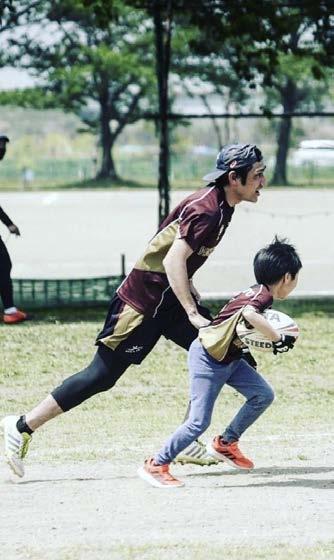
Also, I see university clubs like NSSU having a whole slew of future talent that will soon be the leaders of Japanese Touch … the future of Japan Touch is looking strong.
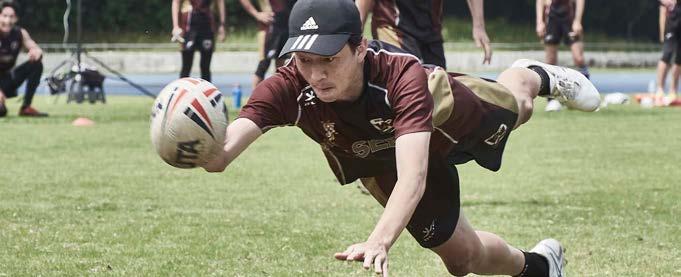
Epilogue:
Unlike Tom Cruise in The Last Samurai, I didn’t magically start understanding Japanese 30 mins into the movie … I’m still at the stage of the movie where I can only
helplessly and drunkenly scream out Sakeeeeee. But somehow I’ve still been able to form an unspoken bond with these fellow touch rugby mates. Somehow my Japanese teammates still patiently put up with me and Biru-san's lack of Japanese.
My respect and admiration for the compassion Japanese show toward beginners and youth is immeasurable. Their attitude toward grassroots growth is something any club can learn from. The loyalty they have toward legacy and building something greater than themselves is something I think that is unique to all the best touch clubs throughout the world. I’m grateful to not only Kona Rugby Academy and Waseda Touch, but all of the Japanese Touch players I’ve met for showing me the great spirit of Japan and Samurai values.
33 thirty-two
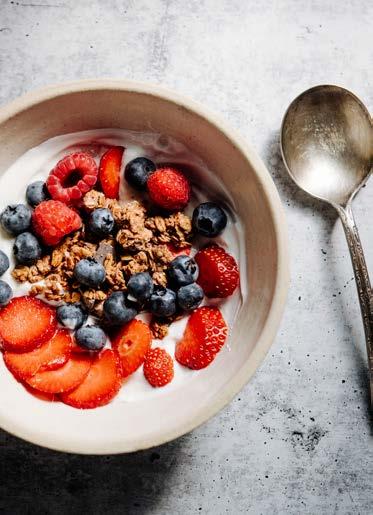

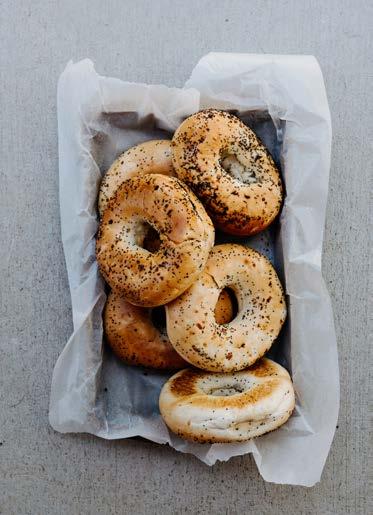

34 thirty-two
TOUCH TOURNAMENT NUTRITION
By Nicola Marsh BSc, MSc, RD, SENr Registered Dietitian & Sports Nutritionist
England Touch Women’s 27s, South East Open Taipan & London Eagles
@marsh_nutrition
Photos Susi Baxter-Seitz
Player
It’s day 3, game 5 and you are 33 minutes in, you’ve just successfully defended 2 sets on the line after your link got pinged (again) for dropping early and your coach shouts ‘go direct’ from the subbox. What have you got left in your legs?
I’m sure all of us can relate to this feeling and sometimes it’s not a nice place to be. But what can we do to make our lives a bit easier? This is where getting your nutrition right can be another marginal gain to optimise your Touch game.
The nutritional science around Touch as a game is currently underresearched (I’m trying!) but we know from other sports that playing multiple high-intensity games across multiple consecutive days makes carbohydrates the essential fuel source for Touch players. Put simply, this is because skeletal muscle’s preferred fuel source during high-intensity activity is carbohydrate and Touch is a highintensity intermittent sport.
So, carbs? We’ve all heard of them, but how do they fuel us Touch players? The good news is, the body has its own store of carbohydrate called glycogen that is stored within the liver and within skeletal muscle. The bad news is, these stores don’t last forever. If you’ve ever ‘hit the wall’ you’ll know precisely what I’m talking about. When muscle stores of glycogen are optimal, most players will have enough fuel for about 90 minutes of high-intensity activity. Whilst a 40-minute Touch game is unlikely to fully deplete muscle glycogen, an inadequate carbohydrate intake compounded by multiple games across multiple consecutive days, may lead to the depletion of stores resulting in fatigue and reduced performance.
35 thirty-two
Carbohydrate requirements will vary between individuals before we’ve even started playing. We then need to consider other variables such as the tournament schedule, the team’s playbook, the squad size and the interchange frequency. All of these factors will influence how much high intensity work is required of you. In simple terms, the longer you spend doing high intensity work, the more important carbohydrates are for you to perform optimally. This is especially prudent if your coach has a penchant for double shifting!
Getting fuelling and recovery nutrition right isn’t always easy during a congested tournament schedule, so breaking nutrition down into important periods of time can be a handy way to go about it. Table 1 details what the nutrition priority is during each period of time including, carbohydrate loading, pre-event fuelling, speedy refuelling between games, and recovery nutrition.
It isn’t just carbohydrates that matter, hydration is a priority during games as highintensity efforts lead to potentially large sweat losses, especially during hot and/or humid playing conditions (ahem Malaysia World Cup 2019). Dehydration can lead to a reduced performance in terms of speed, agility, concentration and co-ordination. Any opportunity to hydrate, therefore, should be taken by the Touch player before, during and after games. Multiple games during a tournament can increase the risk of dehydration, especially if a fluid deficit is carried from one match to the next.
Individual fluid and electrolyte needs will vary from player to player however some key principles are:
1) Start each game well hydrated – the colour of your urine is a handy indication of this.
2) Get to know your own sweat rate – heavy sweaters or salty sweaters should be especially mindful of replacing fluid and electrolytes.
3) Sports drinks may be useful during tournaments to provide carbohydrate as well as fluid and electrolytes.
Just like every Touch player has their unique playing qualities on the field, nutrition strategies will be equally unique. MASSIVE DISCLAIMER: Hopefully you will find a hydration and nutrition strategy that works for you, but, please please please, do not try new products for the first time during an important tournament that you spent weeks and months preparing for. Where possible, take the time during training to practice, to find out what agrees with your body. No one can play their best Touch if they don’t make it off the toilet.
36 thirty-two
Table 1 – Tournament (multi-day, multi-match) Nutrition Guidelines
Period When Requirements & Considerations Examples
Carbohydrate loading
1 – 2 days prior to a multi-match, multiday tournament
Pre-event fuelling Morning of each tournament day & before each game
5 – 7g carbohydrate/kg/day May need to reduce fibre & fats, in favour of carbohydrate rich foods.
1 – 4g carbohydrate/kg @breakfast (opt for lower or upper end of range depending on hours prior to competition)
30g carbohydrate snack approx. 30 – 60 minutes prior to tap off
Example menu: porridge, bagel & jam, fruit juice, banana, ham/chicken salad wrap x 2, flapjack, pasta marinara, rice pudding pot, yogurt & granola/berries before bed
Muesli/granola/cereal with yogurt & berries and a bagel topped with egg/beans.
Banana, cereal bar, dried fruit & nut mix, energy gel/chew/bar, sports drink, smoothie, rice cakes, jelly babies etc.
Speedy refuelling Post-game/ between games
3 Rs:
Refuel – replace carbohydrates used (approx. 1g/kg)
Rehydrate – replace fluid and salts lost
Repair – support muscle repair (approx. 0.3g/kg protein)
Do not rely on venue so bring your own supplies to the grounds.
Chocolate milk
Flapjack & glass of milk
Greek yogurt & banana
Protein shake
Sandwiches with simple fillings e.g. ham/turkey/jam & PB
Rice pudding pots
Sports bars
Recovery End of a tournament day
4 Rs:
Refuel, rehydrate, repair and revitalise
A high priority should be placed on recovery nutrition for the Touch player given they may have as little as 12hours between games for the recovery process.
May want to consider a pre-bed snack as well.
Refuel: ½ plate filled with low GI carbohydrate e.g. rice, pasta, sweet potato, bread etc.
Repair: ¼ plate filled with protein source (0.3g/kg protein) e.g. fish, meat, chicken, eggs, beans, tofu etc.
Revitalise: ¼ plate filled with fruit/ vegetables and include a healthy fat source e.g. avocado, olive oil, oily fish, nuts, seeds etc.
Rehydrate!
References:
Williams C and Rollo I. Carbohydrate Nutrition and Team Sport Performance. Sports Med. 2015; 45(Suppl 1): 13
22.
Thomas DT, Burke LM and Erdman K. Nutrition and Athletic Performance. Medicine and Science in Sports and Exercise. 2016. 48(3): 543 – 568.
Marsh N, Dobbin N, Twist C, Curtis C. Estimates of Energy Intake and Expenditure in Elite Female Touch Players During an International Tournament. International Journal of Sports Nutrition and Exercise Metabolism. 2017 27 (6):1-24
Dobbin N, Thorpe C, Highton J, Twist C. Individual and situational factors affecting the movement characteristics and internal responses to Touch-match play during an international tournament. Science and Medicine in Football 2022
–
37 thirty-two
TOUCH WORLD CUP
As players and NTAs start their preparations for the 2024 Touch World Cup, we’ll take a small dive into past Touch World Cups (Part II). Source (including images): Thompson’s Touch Almanac
The third Touch World Cup took place at Kapiolani Park, Waikiki Beach, Hawaii from March 21st–25th 1995, with the participation of 42 teams from 11 countries (American Samoa, Australia, Cook Islands, Japan, New Zealand, Niue, Papua New Guinea, Samoa, South Africa, Tonga and United States), competing in seven divisions: Men's, Women's and Mixed Open, Men's and Women's Over 30, Men's 35 and Men's 40. It was at this World Cup that the touch world was introduced to the dancing feet of then 16-year-old NZ player, Remus Gentles*. His steps dazzled the Australian defence, leading to two NZ victories before Australia was forced to come up with a way to defend against him in the Grand Final. And thus, the corner/ shut defensive tactic was born, which has since been adopted by teams worldwide.

The final standings per division:
* 7th Touch has compiled historical footage of Remus Gentles in action which is worth a peek
MO WO XO M30 W30 M35 M40
1. Australia
2. NZL
3. WSM
4. COK
5. ZAF
6. PNG
7. Japan
8. USA
1. Australia
2. NZL
3. Niue
4. PNG
5. COK
6. WSM
1. Australia
2. NZL
3. Niue
4. COK
5. WSM
6. ASM
7. Japan
8. Tonga
1. Australia
2. NZL
3. COK
4. Niue
5. WSM
6. PNG
7. USA
1. Australia
2. NZL
3. Niue
4. PNG
5. COK
1. Australia
2. NZL
3. WSM
4. PNG
5. Niue
1. Australia
2. NZL
3. PNG
38 thirty-two
In April 1999, the Touch World Cup returned to Australian soil (Sydney) for its biggest edition yet. 67 teams from 19 countries (notably England, Lebanon, Italy, Scotland, Singapore, Solomon Islands and Wales competing for the first time) played in eight divisions: Men's, Women's and Mixed Open, Men's, Women's and Mixed Over 30, Men's 35 and Men's 40. This TWC was one to remember.
On April 21st, the first scheduled day of competition, Sydney was hit with a hailstorm that smashed the floodlights and damaged the playing fields, forcing games to be rescheduled. When games were finally back on, controversy followed due to three teams fielding ineligible players and subsequently being disqualified. In the end, Australia dominated the divisions, but New Zealand grabbed gold in both XO and X30 divisions.

MO WO XO M30 W30 X30 M35
1. Australia
2. NZL
3. COK
4. Samoa
5. Lebanon
6. ZAF
7. Italy
8. PNG
9. Niue
10. Tonga
11. USA
12. Japan
13. Wales
14. England (disqualified)
1. Australia
2. NZL
3. Samoa
4. COK
5. ZAF
6. Niue
7. SLB
8. Tonga
1. NZL
2. Australia
3. Lebanon
4. Samoa
5. ZAF
6. England
7. COK
8. Fiji
9. Tonga
10. Japan
11. Niue
12. PNG
13. Scotland
14. Singapore
15. Wales
1. Australia
2. Lebanon
3. Samoa
4. Tokelau
5. USA
6. COK
7. Niue
7. PNG
8. Japan
8. Tonga
9. England (disqualified)
9. NZL (disqualified)
1. Australia
2. NZL
3. England
4. Niue
5. PNG
1. NZL
2. Australia
3. Samoa
4. COK
5. Japan
1. Australia
2. NZL
3. COK
4. England
M40
1. Australia
2. NZL
3. Niue
4. Singapore
5. PNG
39 thirty-two
The final standings per division:

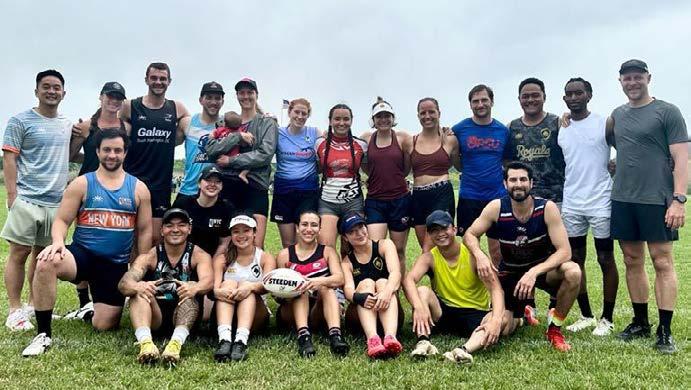


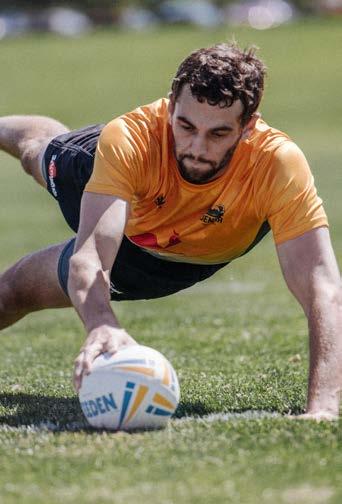
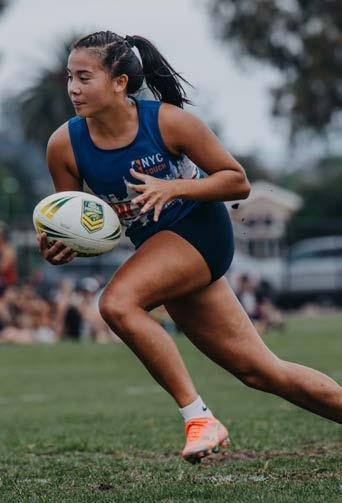

40 thirty-two
ROAD TO TWC24
By USAT XO Photos Susi Baxter-Seitz
When asked to tell the story of this USAT Mixed Open team, I not only look back at the experiences that have led us to this point, but forward to the events that will shape our team and forever change the individuals in it. I see all the trials and tribulations that lie before us.
However, when I visualize my future on this team, only one image passes through my mind, seared into my brain as if a memory despite being nearly a year away. I close my eyes and see myself receiving my USAT jersey for the first time. I feel the pride fill my chest and excitement course through me as I gaze around the room at my team; a group built by the sacrifice and perseverance of athletes who have come from all over the globe to represent one team, one goal, one nation. While looking at the proud faces of my teammates, I see everything that these incredible individuals have gone through to reach this monumental achievement, each person's struggle, incredibly unique and yet so telling of the nature of the sport that we all love.
I see the face of Allison, a 22-year-old balancing the life of a full time college student with the life of a high level athlete in a pay-to-play sport. A young woman whose heart and determination on the field only pales in comparison to her open arms towards our community.
I think of the positive impact she brings to our team, as well as the positive impact she will have on the future of this program. Much like our predecessors paved the way for us to be in the position we are in today, we must always look for ways we can leave the jersey in a better place than where we found it.
I see Simon, a 23-year-old working two jobs to fund his passion. A young man who understands exactly what it means to take on this mantle, hoping to follow his father Matthew’s lead, and help build the inclusive and competitive touch community in the United States. Simon embodies the past and future of USA Touch at once, carrying on his father’s legacy and learning from those who have come before him, while simultaneously trying to blaze his own path, staying true to the unique competitor that he is.
As I open my eyes and return my state of mind to the present, I can't help but feel elation rise through me for what is yet to come. The tremendous journey that lies ahead of us is more than enough to frighten me; but then I remember that it is far more than just me embarking on this task. With my team beside me, there is nothing to truly be frightened of. Together we will make it through this journey, together we will achieve our goal, and together we will soar.
USAT XO is actively fundraising for their Touch World Cup campaign. Please reach out to thirtytwosub@gmail.com if you would like to sponsor a player or make a donation to the squad. Thank you for your support!
41 thirty-two
ADVANTAGE
By Matthew Boesen Photos Susi Baxter-Seitz
Hi Touchies, welcome to a fresh column that will host discussions about referees, refereeing, and being refereed. The goal is to help you react better to referees as a player, to encourage quality play as a referee, and to better understand the refereeing process as a coach. In this first column, we will talk about Advantage.
Have you noticed that players and referees spend a lot of time debating the advantage rule? The war of opinions is intense and hard fought, with few prisoners or cease fires. How long does it last? Why don’t referees call ‘advantage’? Does it give the attack a ‘free play’ to try something risky? Does it excuse an attacking mistake that happens soon afterwards? How does a referee decide which outcome is best? The complex situations invented in chat gives Hollywood script writers enough material to last a lifetime.
As a tradition, any infringement of the rules also creates an opportunity for advantage. The referee encourages the non-offending team to play on and compares the benefit of that play’s achievement on-field, against the benefit of a penalty. By tradition the length of time used to consider these options is about one touch. The most common situation is an offside defender near the scoreline. Allowing a single touch to be played out after the infringement gives the attacking team a pretty high chance to score. If they fail to score, play is brought back to the original penalty. The rule reduces disruption to the game flow, and avoids needless penalties – both great outcomes.
This limited example is simple, but gets more complex around the edges. What if the attackers don’t score, but create an overlap for the following touch? Ask ten attacking players and all ten will say the local cultural equivalent of ‘Dear referee, please keep your whistle in your pocket and let the players play’. The learning point is that advantage doesn’t always happen right now, it is sometimes a promise of a future benefit.
Players expect the referee’s judgement is based on an estimation of what would likely happen if play continued. Is it likely to benefit the attack to keep the ‘in-play’ outcome, or to go back to the penalty for the ‘no-play’ outcome. This is the heart of any discussion on advantage. Referees are trained in these concepts once they reach a medium badge level, and the factors to help make better decisions as they gain experience and skill.
42 thirty-two

43 thirty-two
Start with consistent factors. All players agree that touch count at the time of infringement is important, with a high touch count favouring the no-play option which grants a fresh set of touches. All skilled attackers work hard to establish momentum and defensive misalignment as a critical factor in creating scoring opportunities, which an ill-timed penalty would cancel. Defensive disruption therefore tends to favour the inplay option.
Let’s look at less consistent factors. Distance from the scoreline or from the sub box can be a factor, but not always. Development-level players value distance gained and fresh touch count far more than elite-level players. A fitter team might favour the in-play option over a less fit team. A muddy field or heavy rain make momentum harder to establish, so no-play is favoured. A close score difference puts pressure on a team to create or avoid stoppages in play, with the team ahead on score wanting to burn time in stoppages, and their opponent wanting to maximise play time.
Which factors are most important to which games and conditions is open for debate. Regardless, the referee is obliged to make a decision in a very short space of time. Great referees plan these factors in detail. A referee can make themselves aware of attacking and defensive policies by observing teams in prior games to better recognise beneficial patterns. Weather effects can be planned before a day starts. By making these plans a part of pre-game preparation, a referee’s decision matrix tends to deliver better advantage outcomes to the non-offending team.
There is no single shirt size that fits all. But some shirt colours don’t seem to suit anybody. We all have seen an attacker stop play, point at the penalty, complain to the referee, and then wonder why no advantage is ever achieved. The player didn’t offer an in-play benefit, so the referee had no option to compare with. Experienced players know they have nothing to lose by playing, and everything to gain, so they try to score with any option – even a low-probability long ball. Referees always appreciate a player trying to resolve their own advantage by playing it out.
Different expectations across levels of experience is the reason why referee training does not include the call ‘advantage!’. Experienced touch players don’t need that call. Inexperienced players can take the wrong message from that call. Rugby-trained people disagree, but advantage lasts far longer in that sport, so the contrast isn’t sound to consider. Time has proven that “advantage!” isn’t a helpful call to develop as a habit in touch because there are better calls to make.
Referees call “Play on” to encourage the play to continue and, just as importantly, to ensure that any players don’t unexpectedly stop playing. If some players stop while others continue, chaos is the outcome, and all referees dislike chaos and the control and credibility gaps it creates. A better call is “Link offside play on” which indicates where the attacker should attempt a score, as contact initiated by the link would be ignored. Great communication maximises the opportunity for the attack to get an in-play benefit.
[Side Note : Recommendations for clear and concise communication will be the subject of a later in-depth article].
As a player, if you recognise that advantage is yours then stick to your gameplan and play your best move. There isn’t a rush amongst coaches to create a ‘special play’ used only during an advantage situation, so the only alternative that makes sense is to keep following your gameplan.
Advantaged attackers near the scoreline can learn a valuable skill. When a referee indicates an offside player, always try to ground the ball in that gap. Even when touched, one opposing defender’s contact is not legal, so your grounding may well be a try! Don’t be foolish though. It costs less than a half-second of play if done well – just a simple swift touch of the ball to the line and then get back for your rollball. The referee now has the easiest choice – if that player was offside a try is awarded. Otherwise rollball for advantage play, or penalty for no-play outcome. Every referee loves a player who knows how to ‘work’ the advantage rather than surrendering it.
44 thirty-two
Some coaches observe errors or inconsistency in how penalty/advantage situations are assessed. The most loathed error is a referee blowing a penalty immediately when an offside defender at the scoreline makes a touch. The touch is not legal, and so the ball and play remains live! Hasty reaction by the referee takes away the opportunity for an in-play benefit, and attackers are rightfully disappointed by this outcome.
Another situational error can occur in penalising offside defenders before an attacking team’s drive reaches its own sub box. The penalty not only takes away the attacking momentum, but also rewards the defenders with the opportunity to realign and aggressively defend after the penalty. This example shows how a poorly judged penalty can create more harm than good for the non-offending team. An exception is when a penalty
is used to change behaviour or restore order, perhaps as part of an escalation process, which is necessary for safety or game control reasons.
People also sometimes relate morals to advantage situations and determine whether a team ‘deserves’ an advantage option. That is an error. The rules offer advantage as a way of reducing disruptions to a game, and to keep focus on players instead of referees. The alternative is referees being trained to always blow penalties, and defenders learning to disrupt play with no real disadvantage. Nobody would like that game more than what we have now. Advantage is a simple concept, and when done well by players and referees makes for even more flow and excitement in this game that we all love.
[Side Note : You may have consulted the FIT 5th Edition Rulebook and discovered that the Advantage Rule has been changed from the FIT 4th Edition. While 4th wasn’t perfect, it provided a broader scope and clearer direction. Under 5th the only trigger is Defender Offside. This limitation confounds players, coaches and referees in equal measure. You may also observe that “Advantage” means all of these things: a period of time, a territorial or tactical benefit, a right of a team, the comparison of two outcomes, and the name of a Rule? Without meaning any disrespect, this is an example where we should set the rulebook aside, and use our collective brains to chart a sensible and beneficial pathway together.]

45 thirty-two
This is an independent publication. We are based in the US and welcome article submissions about touch from around the world. Articles, comments, complaints, grivances and praises can be submitted to thirtytwosub@gmail.com thirty-two

























































